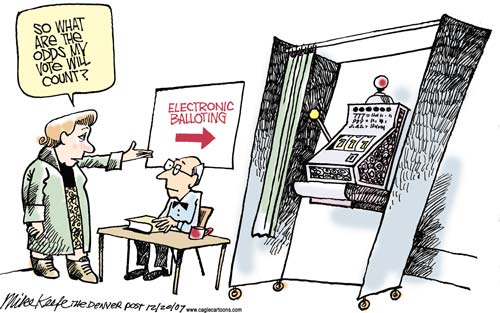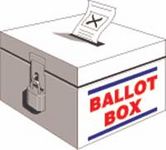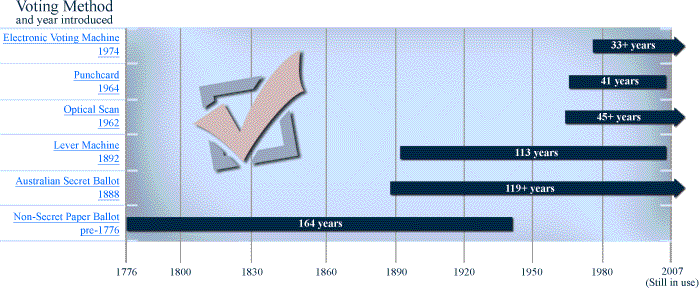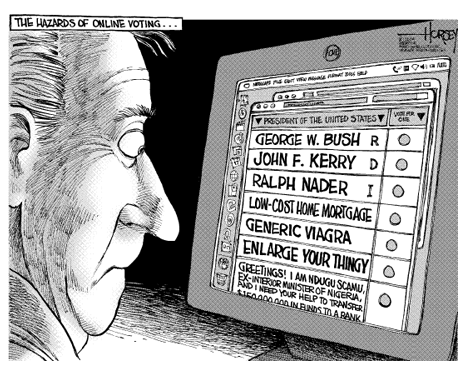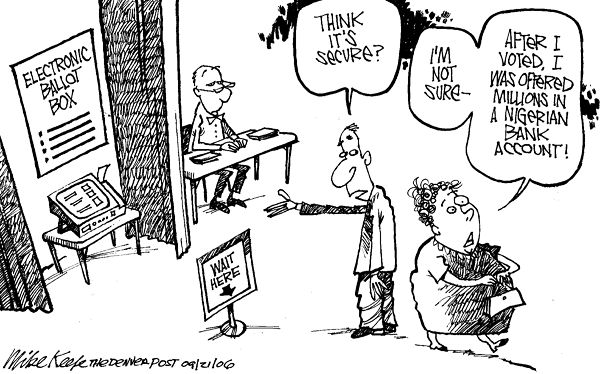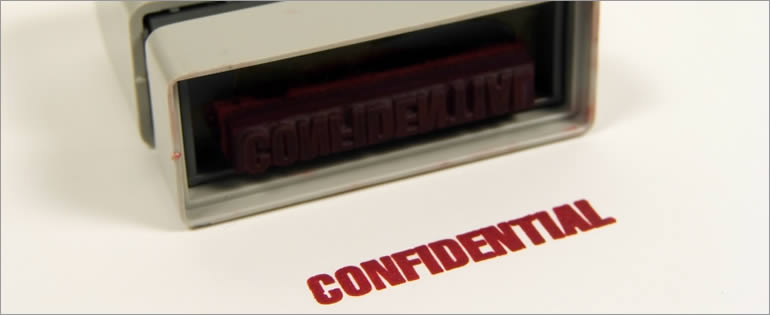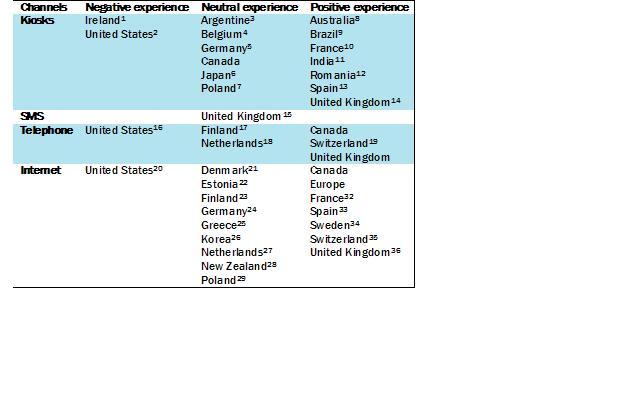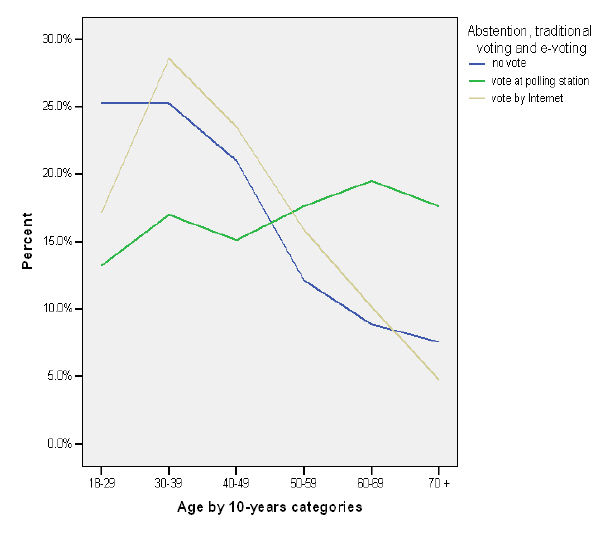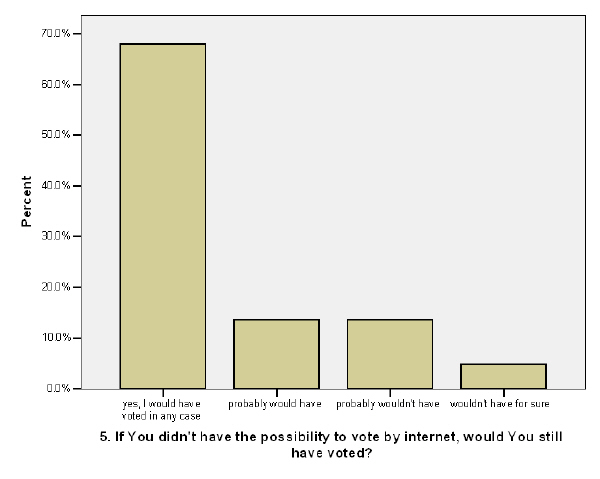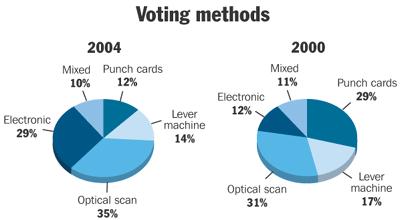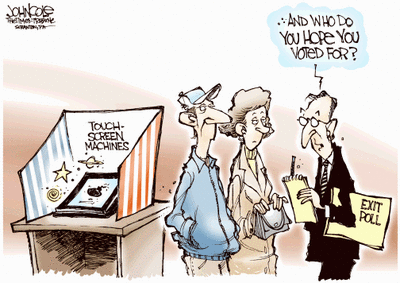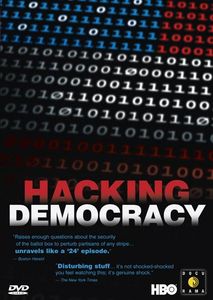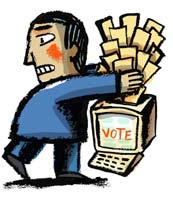Electronic Voting...or Gambling Your Votes Away???
Contents
- 1 Group Name
- 2 Group Members
- 3 Initial Project Statement
- 4 Argument
- 5 History of Electronic Voting
- 6 How It Works
- 7 Advantages/Disadvantages
- 8 Characteristics of Good Electronic Voting Machines
- 9 Psychology of "E-voting"
- 10 Statistical Data
- 11 Problems with Voting Machines
- 12 Help America Vote Act, 2002
- 13 Documented Problems
- 14 Conclusion
- 15 References
Group Name
"The Gamblaaz"
Group Members
Erika Angyalfi, Samantha Evans, Ashley Kosasih, Lindsey Rizkalla, Petra Vadelova
Initial Project Statement
In this project we explore the issues that begin to surface as controversies surrounding Electronic Voting are brought to the publics attention. Using internet resources and magazine articles we investigate the credibility of Electronic Voting Machines by first looking at the history and development of voting machines, followed by an exploration of the functions of this system, its advantages and disadvantages and lastly we look at the documented problems. We will utilize this gathered information to provide an educative conclusion.
Argument
Electronic Voting Machines were first presented as a solution to a growing problem with the previous voting machines. However they have just made the problem worse. Many recorded problems such as software errors, impossible recounts and the opportunities for fraud have just worsened the current voting machines. Each new and improved machine comes with new problems, so why, in today's rapidly advancing society, can't we get a simple voting machine right?
History of Electronic Voting
Caveman Days-1856 [1]
Voting has evolved past the prehistoric stage of simply raising a hand when your choice was called. As technology has rapidly progressed throughout a very short time frame, the process of electronic voting has grown along with it, beginning with the first use of a uniform official ballot by the Australian government in the state of Victoria rightfully known as the “Australian Secret Ballot.” This simple process was first developed in 1856 and consisted of handing a citizen a piece of paper with the candidate’s names and issues that are all counted by hand. The uniform official ballot lasted solely for 34 years and is still used in some areas today.
1889-1930
New theories and methods of how to improve the method of voting started to circulate in 1889 when Jacob H. Meyers of Rochester patented the first ever mechanical lever machine. This technology solved the problem of dishonest counting, prevents overvotes, and greatly speeds up the vote counting process. It was first used in 1892 and by 1930, had been installed in virtually every city in the United States.
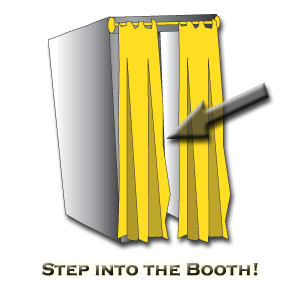
1962-1974
It was not until around 1962 and later that many different voting systems started to surface, including variations of the punchcard voting system (Votomatic and Video Voter), computer tally machines, and the direct recording electronic (DRE) voting machine which was invented in 1974.
1975
With so many different systems being introduced, the quality and reliability of the voting process soon began to be questioned. In 1975, Roy Saltman prepared the first of many reports to evaluate computerized voting technology.
“Effective Use of Computing Technology in Vote-Tallying” investigates voting system security, design, and functionality, as well as the ability to conduct audits of election processes, and ballot recounts. This report will later initiate the federal Voting Systems Standard program.
1977
James O. Narey and his partner patent the first ever model of the modern precinct-based optical scan systems used today.
1987
Shoup Corporation and Chief Engineer patent Shouptronic ELECTronic voting machine. The push button device was the first direct recording electronic machine to receive commercial success.
1990
Federal Election Commercial releases the first set of standards for electronic voting machines. This requires machines to uphold a certain criteria and must perform at a certain level before they are deemed suitable for public use. While Canada has no set electronic voting standards at a federal level, many provinces at a municipal level use systems that have been certified to United States standards.
How It Works
Imagine not having to get out of your bed to vote for the next upcoming election, be it federal, provincial, or local. Now with electronic voting, you could do it right from your very own personal computer. This new form of technology is commonly called "E-voting" and refers to both the electronic means of casting your vote for your preferred candidate, and also the means in which the votes are tabulated. By this particular definition, many already existing forms of voting already qualify as "E-voting." These include punch cards and optical scan cards. The results of these types of voting processes are tabulated electronically and have been used for decades.
There are two main types of electronic voting being introduced into society. Direct Recording Electronic (DRE) Systems, and Voting on the Internet (VOI). Both of these systems are subject to criticism from the public, but with the continually growing population of those who are able to vote, just think about all those ballots that would be have to be coordinated by hand and manually counted. Before "E-voting" people would have to go to their local polling facility during the set hours. Volunteers would then make sure that you were indeed a registered voter, then you'd go to a little booth and cast your ballot. Once closed, election officials would take the ballots to a centralized tabulation site where they would count and report the results. A very long and frustrating process. This process, the paper-based system, is currently the most common used form of voting, but it still possesses an electronic component.
Paper-based Systems
With a paper-based system, the electronic compnent is usually a tabulation device. This means that the results from elections are counted and reported with the help of an electronic system. This is a great deal faster than counting all the ballots manually. Voters use a touch screen, or a similar device, to make their choice. Then a printer, which was attached to the device, prints out a ballot. The officials then take all the ballots to a centralized location where seperate electronic devices optically scans and tabulates the results.
Direct Recording Electronic (DRE) Systems
DRE systems are essentially computers. Voters view ballots on a screen and make choices using an input device such as a bank of buttons or a touch screen. Some DRE systems also employ a card swipe system that must be activated before the casting of the ballot. The votes cast are then stored on memory cards, CDs, or other memory devices. Once closed, the officials transport the memory devices from each machine to centralized locations for tabulations, much like they would with paper-based systems. Some DRE machines also have the ability to broadcast results over a modem-to-modem line. However, due to concerns with data security, these votes arent always counted as being official until verified by tabulating the results which are stored on the memory devices. Many of these DRE systems can also print a paper record of ballots cast for furter verification.
Voting over the Internet (VOI)
This experiment was first piloted by the Federal Voting Assistance Program (FVAP) in 2000 to see if election votes could be reliably and securely cast over the internet. Upon the adoption of this system by the FVAP, it was the first time in the United States of America that ballots cast over the internet were counted as legitimate in federal, state, and local elections. This system was designed to cast votes, not to tabulate them. Volunteers recieved a CD that had a browser plug-in which displayed and transmitted ballots to the FVAP servers. The Department of Defense (D0D) included a digital certification program which made sure that each and every voter was authentic and registered. Once a ballot was submitted, the DOD would then deactivate the voter's certification so that they were not permitted to cast more than one ballot for the election. The server to which the ballots were transmitted was in a secure location with very limited access and an uninterrupted power supply. There were also two intrusion detection systems which were installed for the purpose of monitoring any attempts of fraudulent activity.
Advantages/Disadvantages
The three previously discussed systems for electronic voting all have their advantages and disadvantages. Let's discuss these in greater detail.
Paper-based Systems
Advantages
- The ballot is represented by a piece of paper. This reassures voters that their votes are being counted.
- Everything is manually counted and verified so that there are no mistakes made in the final results.
- This system has been used for a very long time which means that it is trusted by the public.
Disadvantages
- Takes a lot of time and effort to correctly seperate and tabulate the votes for each candidate.
- Ballots can be lost in transportation from polling centre to tabulating location.
- Requires more volunteers for counting and tabulating the ballots.
Direct Recording Electronic (DRE) Systems
Advantages
- This system is more reliable than paper-based systems.
- The ballots are displayed electronically so there are no limitations on their appearance.
- Programmers can create ballots in any language to facilitate those who do not speak the local language.
- Print layouts can be enlarged for those who have poor eyesight.
- Programmers can incorperate audio files for blind voters.
- There is no need to estimate how many ballots will be needed for each polling site.
- The final tabulation of the results takes a lot less time.
- There are no paper ballots to scan so there is no room for mechanical error.
Disadvantages
- There is always the possibility of voter fraud where someone who is not a registered voter can hack the system and vote anyways.
- Programmers can be bribed to make certain changes the the programs.
- With the required auditing laws, it is difficult for programmers to create an auditing process that still preserves voter confidentiality and anonymity.
- DRE systems are costly and the costs of maintaining these systems are unknown at this point.
- Paper jams with printers.
- Possibility of running out of ink.
Voting Over the Internet (VOI)
Advantages
- Registered voters don't even have to leave their home to cast their ballots for their preferred candiates.
- A lot quicker than other systems.
- Will most likely increase voter participation because of the new level of convenience.
- Reduces election costs.
Disadvantages
- Possibility for hackers.
- No one is there to answer any questions or concerns that you may have about the election process.
- Easy to forget to vote because nothing is reminding you to cast your ballot.
- Possibility of being denied service.
- Any number of viruses.
Characteristics of Good Electronic Voting Machines
For electronic voting systems to be accepted among the public they have to have certain characteristics that make them reliable. Some of these characteristics include the following:
Accuracy -
For an electronic voting system to be competely accurate, it has to satisfy the following conditions:
- It is not possible for votes to be altered. This puts the public at ease when they are casting their votes because they are assured that who they have voted for is actually going to recieve their ballot.
- It is not possible for a vote that has been cast to be removed from the final tally of the votes.
- It is not possible for any invaild votes to be counted for the final tally. This prevents fraud which is a major issue in the electronic voting systems debate.
Democracy -
The electronic systems have to follow a democratic voting system. This means that only eligible voters are permitted to cast a ballot, and that these voters are only allowed to vote once during the election.
Privacy -
Privacy is very important to the public when they are casting their votes. A system is considered to be private if ballots cannot be traced back to the voter by anyone, including election authorities. A system is also said to be private if no voter can prove that he/she has voted in a particular way.
Verifiability -
Any voting system has to be verifiable. A system is considered to be verifiable if anyone can prove that the ballots have been cast and counted properly without any mistakes.
Convenience -
No one really enjoys having to take time out of their day to go cast their vote. Therefore, voting systems must also be convenient for the public. A system is convenient if voters can cast their ballots quickly, in one session, and with minimal equipment or special skills. This sense of convenience will also cause an increase in voter participation among the population.
Flexibility -
Flexible voting systems allow for a variety of ballot question formats, which also include open-ended questions.
Mobility -
A system is considered to be moblie if there are no restrictions (other than legal ones) on the location from which a voter may cast their ballot.
Psychology of "E-voting"
For the public to start accepting the concept of "E-voting", we must first put faith into the fact that elections are fairly conducted as to ensure democratic governments are considered to be legitimate. At this point in time, there is a lot of debate towards this new electronic system for voting. Because of this, citizens, private comapnies, and elected officials are spending more time carefully examining the systems and assuring the public with their credibility.
Though debates on the subject are on-going, critics of electronic voting recognize that moving towards "E-voting" is an inevitable step in the evolution of our voting process. These systems must be shown as fair, secure, and reliable before the public will fully accept it as the new voting system. Major concerns about the adoption of this system include reports of lost data, corrupted files, bribed officials, vendor partisanship, and unsecured information. More tests of these systems will have to be conducted before all wrinkles are ironed out.
Statistical Data
An experiment was conducted on citizens of several countries upon their experiences with e-voting as seen in this chart. In both Brazil and India, the government had access to the source code, the machines were operated by security officials, the illiterate were able to vote, and the counting process was reduced. Australia, Belgium, and Netherlands all have machines that have their source code available for the public to view. Several countries choose a multi-channel path, which means that electronic voting is not the only option available (mailing, telephone, etc.) Countries using a multi-channel path, Denmark, Netherlands, Portugal, Spain, Switzerland, and United Kingdom, usually have mainly positive experiences. Having a paper back up for the e-voting may be desirable because it can prevent technical problems that skew the results as well as hackers corrupting results. Often times, countries may have bad experiences when they implement new unfamiliar e-voting technology for familiar electoral processes. In the US, the negative experiences may have been avoided if citizens were given access to the source code, if the implementation of the e-voting process was more gradual, or if a multi-channel path was used.
Younger people prefer to participate in voting over the internet while older people do not usually vote over the internet. Younger people also prefer not to use polling stations while older people prefer them. Many non-voters are young people, while the majority of young people are e-voters. This means that there may not be many young people voting, but of those that are voting, they are e-voting. Perhaps young people have a great voter apathy and evoting is the only way to get them to vote.
A survey was made questioning participants whether or not they would have still voted if there was no internet available for evoting. About 67% of evoters said that they would have voted in any case and 14% said that they probably would have voted. Therefore, 81% of evoters would have voted even if there was no evoting. Only 14% of evoters said that they probably wouldn't have voted and 5% said that they definitely would not have voted. Only 19% of evoters would not have gone to vote if evoting was not available.
The following pie charts represent E-Voting Machines' Confidence Gaps between 2000 and 2004. The largest concern with e-voting machines is their accuracy and integrity because most of them do not have voter paper printouts for verification and there is no way to determine whether they have been calculated correctly.
Problems with Voting Machines
Many technologies throughout time have helped us cast our ballots, but the new computerized machines promise more efficiency than before. Each voting system has four required characteristics:
- Accuracy
- Anonymity
- Scalability &
- Speed
Additional technologies get in the way, and essentially create more potential errors. With trying to improve the voting machines with speed and scalability, accuracy has been sacrificed by adding additional steps. At each, single step errors can occur.
The three major problems with the DRE voting machines are:
- Software errors
- Computerized systems have lost votes, subtracted votes instead of adding them, or even doubled votes; which affects one candidate more than other, they do not cancel out[2]
- No one knows how to write a bug free system and therefore bugs are commonplace
- Opportunity for fraud
- A Corrupt insider could hide a malicious code in the software as it is being made
- The officials working during the elections are not computer experts
- No voter verified paper ballot
- DRE voting machine do not provide any method for the voter to inspect how their vote is stored in the system's memory
- The printout of the electronic record is not accurate, and it goes undetected because the voted is not there to see the error
This film managed to prove that the current voting machines are vulnerable to undetectable hacking. Some of this software hackers could be working for the companies that distribute the software. Therefore once it is in the software it is distributed to all the machines of that company. Currently three major companies provide 80% of America's voting machines and about 87% of votes in America are counted by Electronic Voting Machines. With these alarming results, what all are we willing to sacrifice to achieve speed and comfort with our voting?
* In 2007 the Documentary was nominated for an Emmy Award in Outstanding Investigative Journalism
Help America Vote Act, 2002
On October 29, 2002 President Bush signed the Help America Vote Act into federal law. This Act was formed because of the controversies surrounding the 2000 presidential election. Under this act states are required to implement election reform efforts to improve the voting system. Some of the requirements are:
- Create a statewide, central voter registration system
- Certain voters would need to satisfy an identification requirement before voting
Because of problems in the 2000 elections, close to 2 million ballots were disqualified and therefore some of the goals of this Act are:
- replace punch card voting systems
- create a commission to assist in the administration of federal elections
- establish minimum election administration standards
Documented Problems
There have been a few documented problems and controversies related to the use of electronic voting systems. One of the most well known is the United States’ presidential election of 2004. After the Help America Vote Act (HAVA) was passed due to the Florida confusion of the 2000 presidential election, many states were upgraded with new electronic voting machines. Even though the government supposedly spent about $3.8 billion on the new equipment, several of the machines were reported having security risks and unfixed problems. In particular, the DRE and OpticalScan voting machines were found to have many glitches, and it is likely that some of the bugs were not fixed in time for Election Day.
Approximately 30% of the electronic voting machines used in the 2004 election did not print the votes out on paper, so a recount was virtually impossible, not to mention that without some other way of recording the votes, there is no way to know if they were counted properly in the first place. The totals can be stored in the backup devices of the machine, and it can be monitored for abnormalities, but in the end the vote count will not change once it is stored in the computer. There were also some security concerns with the machines, as many experts claimed that the machines were not tamper-proof. In addition, there was the issue of malfunctioning machines, because, after all, they are only computers, and there is a possibility they could break down. During the 2004 election, one machine even started counting backwards to 0 once 32,000 votes were recorded
There have also been some documented cases of faulty electronic voting machines in state and county elections. In November 2003, a Hinds County, Mississippi election went wrong after the brand-new touch-screen electronic voting machines began failing and overheating, resulting in a rerun election being called by the candidates two months later. Similarly, in elections taking place in Maryland and Fairfax County, Virginia, some voters watched the X on the computer screen jump from the Republican candidate’s space to the Democrat’s. In both of these cases, DRE machines were used and there were no backup paper ballots, so there was no way of auditing the results.
Recently Documented Computer Errors[3]
- Cateret County, North Carolina, Nov. 2004: 4438 electronic ballots were lost and never recovered due to problems with the software
- Fairfax County, Virginia, Nov. 2003: Several voting machines subtracted one in every hundred votes for the candidate who lost her seat on the school board
- Broward County, Florida, Jan. 2004: 134 ballots were left blank in which the margin of victory was 12 votes
- Collin County, Texas, Nov. 2006: Touchscreen machines flipped the vote from Democrat to Republican
- Lancaster County, Pennsylvania, Nov. 2006: 67 out of 232 machines would not scan the paper ballots that they were fed in
- Broward and Miami-Dade County, Florida, Nov. 2006: The candidate chosen by the voters did not show up on the screen
- Marion County, Indiana, Nov. 2006: 175 of the 914 precincts in the county were forced to use paper ballots after the machines refused to start up
Conclusion
Over the past couples decades the DRE systems have gained a strong following. Especially in the United States the goal to replace all systems of voting machines with the DRE systems have been put in place. Through our extensive research we have found many pros and cons and problems with the DRE systems. Many ethical issues arise when dealing with these machines, such as easy access into the system for hackers resulting in a skewed vote. However, these systems can be more reliable than a paper-ballot and the electronic ballots are easily altered for handicapped individuals. Still these systems are costly, but as technology keeps advancing the possibility of cheaper and more reliable systems can become a reality.
References
Erika's:
Characteristics of Good Voting Machines
Sams's:
Petra's:
Problems with e-voting? Blame the humans
Summary of the Problem with Electronic Voting
More E-voting Problems Reported
Who Do Hope You Voted For? Cartoon
Ashley's:
Lindsey's:
2004 US Presidential Election Points of Controversy
Electronic Voting in the Election
Has This Happened To Your Vote?
